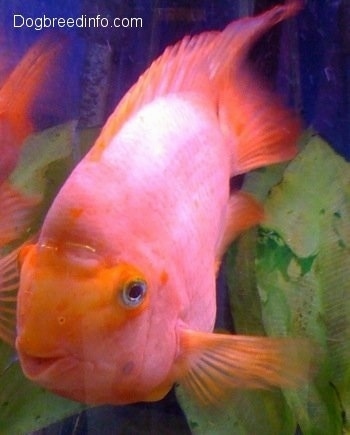
No binomial nomenclature, hybridized using combinations of either Midas cichlid, Redhead cichlid, Severum cichlid or Red Devil cichlid. Their peaceful temperament suggests they have Severum genetics.
Cichild
Presumably would a part of the Cichlasoma genus, however scientists cannot give it an official family.
--
Red Parrot Fish, Blood Parrotfish. Do not confuse it with the Parrot Cichlid. Also, is not related to the saltwater Parrot fish.
55-gallons
Top, mid
Easy
Gentle cichlid behavior. Relatively peaceful. Active and energetic, will actively grub for food at the surface. Will attempt to ingest fish much smaller than itself; must not be kept with small community fish such as tetras or small barbs. As with any cichlid, temperament can vary between each individual fish. Can be territorial in smaller tanks. Generally do not rip up live plants or attempt to rearrange decor.
Commonly kept with severums, younger oscars, and other cichlids of similar size and gentle temperament such as Firemouths or Flag cichlids. Can also be housed with large peaceful fish, such as bala sharks and silver dollars. Clown loaches and synodontis catfish are usually ignored. Ensure they are in a large enough tank that they do not become too territorial. Due to their misshapen mouths, they do not compete for food well. Care must be taken to assure they are being fed.
Up to ten years. Possibly more with larger tank and consistently exquisite water conditions.
The larger the tank, the larger the size, but tops out at eight inches.
Plastic weighted plants, large rocks, possibly driftwood. Formations of rock are utilized as caves and hiding places. Like many cichlids, the more places they have to hide results in them being less timid and shy. Medium-sized gravel. Aim for softer or smoother gravel, as they like to dig. Live plants will not be torn by Blood Parrots, but other cichlid tankmates may rip them up. Longer tank vs. taller tank is less of an issue, as Blood Parrots will utilize most of the space given to them. Cichlids are generally rather messy fish and require at least 30% water change once a week. Lighting should be low to moderate.
Fresh
6.6-7.0 or thereabouts. Can survive in ranges from 6.5 to nearly 8.0.
Softer side of neutral.
Around 80° F. Paler in cooler temperature.
Omnivorous. Will eat just about anything that fits in their mouths. Can be fed any food formulated for cichlids. Flake and sticks happily accepted; live, frozen, and freeze-dried greedily devoured. Feed brine shrimp only as a treat. At adult size, they will accept typical house insects, including flies and cockroaches. They also accept feeder guppies and goldfish, but these are not good choices due to possibility of disease and lack of proper nutrition. Always supplement with food marketed for cichlids to ensure a well-rounded, balanced diet and a healthy, long-lived fish.
Difficult. Males show a pinkish hue around gills and throat during spawning.
Will breed with non-hybrid fish, but are infertile when bred with another Blood Parrot. Will care for eggs and fry in the territorial, fastidious cichlid manner.
Not found in wild.
Man-made hybrid fish of the midas and the redhead cichlid. Many hobbyists dislike the Blood Parrot, as it is not a naturally occurring fish. They are prone to spinal and swim bladder problems due to their round body type. Although their mouths do not fully close, they are still capable of eating well due to strong throat muscles. Most common disease is Ich, characterized by small white spots on the body of the fish. Can be treated with Rid-Ich and similar medicines, but is easily combated with non-iodized salt and heightened temperatures. 86° F for three days will speed up the disease's process, and salt will destroy it. Can also be found in the "jellybean" variety, with colors ranging from green to blue. Be aware, the natural color of these fish is and always has been orange or calico. Jellybeans are tattooed or dyed fish. Dyeing and tattooing are highly destructive ways that breeders will attempt to market their fish. Do not ever buy a tattooed or dyed fish, as their lifespan is severely reduced and they are more susceptible to deadly disease. The tattoo or dye will also disappear within a month's time. Do not buy into this barbarian practice.
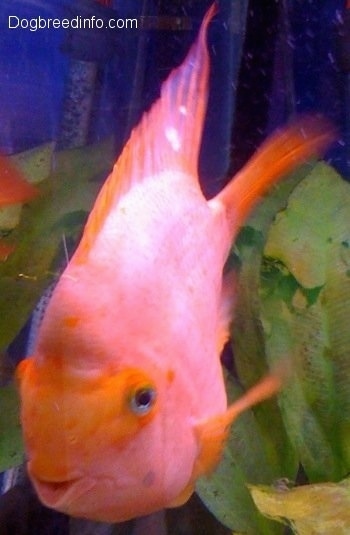
Blood Parrots look like they are smiling at you.
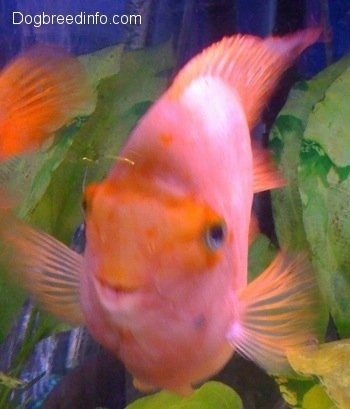
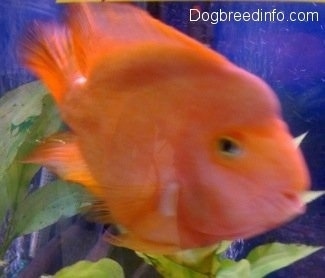
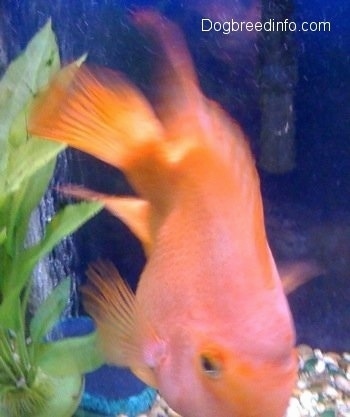

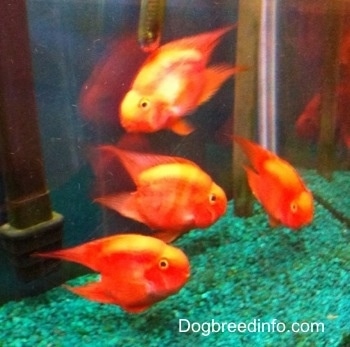
Baby Blood Parrots
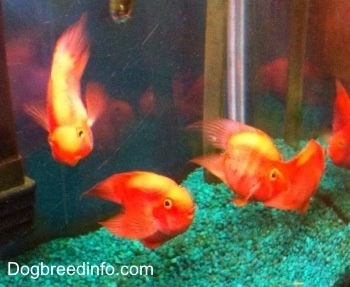
Baby Blood Parrots
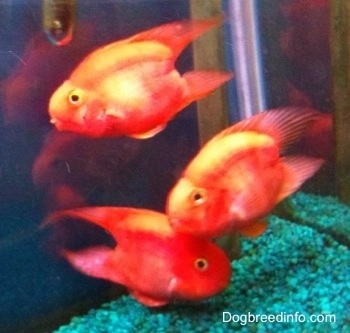
Baby Blood Parrots

Baby Blood Parrots